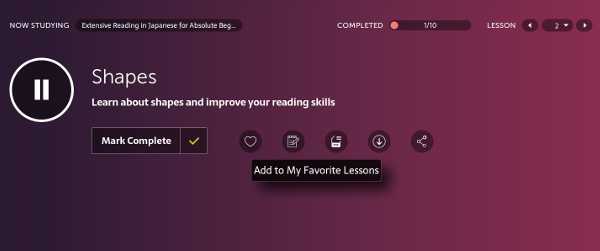JapanesePod101 Review: An In-Depth And Detailed Look
 Written byHubert Nagel
Written byHubert Nagel- Read time8 mins
- Comments0


- Plenty of varied lesson content
- High quality Japanese lesson podcasts
- Inexpensive
- Lower quality video lessons
- Lesson navigation could be improved
JapanesePod101 have maintained a good level of consistency with their lesson quality, and the ‘Learning Paths’ feature is an enormous improvement to lesson navigation. Overall, a good option for anyone learning Japanese.
People contact me all the time about learning Japanese.
“I really want to learn Japanese. How do I get started? What are the best resources for learning Japanese?”
It’s no surprise that this language is one of the most popular languages to learn. It’s estimated that there are around 125 million native speakers in the world and Japan is one of the most popular destinations for foreign expats to live and work.
Japanese culture (both modern and traditional) is fun and eccentric in many ways, Japanese people are some of the friendliest people and anime is enormously popular all around the world.
If you love Japan or need to learn Japanese for any reason then of course, you need the right resources.
I often recommend Rocket Japanese as a structured course suitable for most people in conjunction with a tool like italki but for those looking for a podcast-style audio supplement, Innovative Language’s JapanesePod101 is enormously popular too.
One thing that sets JapanesePod101 apart is that it really aims to suit all learners, is dynamic and provides a good amount of audio and video lesson types.
Before I get started, I just want to share some responses I received from Innovative Language after asking them a few questions. Here’s what they told me:
Regarding JapanesePod101’s teaching style:
Innovative Language believes in practical expressions, aligned to CEFR proficiency levels, in the natural context of native speech. Most lessons, then, begin with a dialogue in which a language skill is introduced in context. The rest of the lessons then go on to talk more about the cultural context in which the dialogue takes place, and the key vocabulary, phrases, morphology, and syntax that allow the learner to carry out the particular language task.
This is an approach I often promote on this blog in fact (you don’t need to study grammar to learn to speak a foreign language).
I also asked them about the level of creativity that JapanesePod101 teachers have when making their lessons:
The native speakers who create the content have a lot of freedom to choose what they teach, though we have a few standard series, such as Survival Phrases, that teach roughly the same kinds of expressions across all of our languages.
Innovative Language lessons are aligned to CEFR levels, and we typically ask that teachers try to teach to a standardized set of internal Can Do statements when preparing the dialogues and the grammar and vocabulary information.
This liberty is fairly apparent throughout the lesson material. I’ll explain below.
The JapanesePod101 structure now compared to what it used to be
One of the major criticisms of JapanesePod101 has always been its messy, unstructured lesson content.
When you have a dynamic learning platform that is constantly adding new material, it’s difficult to keep this in a structured format where lessons are easy to follow and find.
JapanesePod101 attempted to remedy this problem by incorporating Learning Paths.
What it does is groups lessons into targeted topics and levels that follow a ‘path’, so you can move through a linear direction and not be left wondering, “what do I study next?”.
Think of them as lesson modules.
For example, there’s a module called Japanese Reading Comprehension For Absolute Beginners which contains 10 lessons at 11 minutes in total (short ~1 minute lessons). Each module shows you the total number of lessons + time it takes to complete all of them.
Overall, the Language Paths have received good feedback from other learners.
JapanesePod101 leaves the direction up to the learner – course structure is optional
But it’s important to emphasize that Learning Paths are optional for Japanese learners who don’t like to be limited by any imposed structures.
When you first get to the JapanesePod101 dashboard, it can be overwhelming.
For people who like to be hand-held through the learning process, the Learning Paths are there to provide guidance on where to go next.
However, independent and experienced learners can ignore it.
The lessons are all in strict ascending order of difficulty which you would expect them to be. Even if you decide to follow JapanesePod101’s Learning Paths, they’re a little messed up. The focus seems to be on teaching by topic rather than level.
You can find lessons ranging from Introductory/Absolute Beginner (made up of a lot of cultural info and language basics) up until Advanced.
Within these level categories are both audio and video lessons (see below).
As mentioned above, JapanesePod101 focuses on themes and practical topics, rather than grammar. It’s useful language and something I believe to be a strength.
Lessons are short and straight to the point on practical topics.
There seems to be more than enough content available to keep most learners busy for a long time.
Learning Japanese from the video lessons on JapanesePod101

The JapanesePod101 videos have come a long way over the past year or so but still need improvement.
There are still a lot of really low quality videos that have carried over from the early days of JapanesePod101. Some of them are more like slide shows with an audio track.
I would hardly call them “video lessons”.
But there are now plenty of outstanding new videos that cover all kinds of interesting content, from writing Kanji, Katakana and Hiragana to walking around the streets of Japan playing Pokemon Go.
Risa’s video are by far my favorite and fun to watch.
With the newer video additions there are plenty of video lessons to keep visual learners busy.
JapanesePod101 and its podcast audio lessons

The audio lessons in JapanesePod101 seem to be presented by a few different hosts in English with Japanese dialogues.
Naomi and Peter lead the more recent lessons.
Since it’s a podcast audio lesson style, the lessons are typically recorded as ‘banter’ – general chit-chat between the two hosts where one hosts asks the other one questions.
Some people love learning this way.
However, I much prefer to skip this and focus solely on the Japanese dialogues.
Thankfully you have the option in JapanesePod101 to skip the banter and only listen to what matters but it’s entirely up to you.
You can also pick out individual vocabulary or listen to specific lines of the dialogue – lots of options.
Best part about it is that it’s all completely downloadable so you can store it on a listening device for your commutes.
Like Rocket Japanese, you can (if you want to) download the entire site’s audio content and keep what you paid for.
You’re also able to record your voice and compare it with the native Japanese speaker (rather than use their Premium Plus pronunciation correction service).
I prefer to use italki for this but it’s a good feature to have.
Good and bad additional features in JapanesePod101
The Innovative Language notes are outstanding.
One thing that is very clear is that an enormous amount of careful work has been put into producing quality PDF lesson material.
My advice is to save all of these and/or print them out for future reference when studying Japanese.
JapanesePod101 has a lot of features – some of them are what I call ‘feature fillers’ however – just extra stuff that isn’t really that helpful but adds to the overall product value.
Take for example the grammar section.
I just think the Innovative Language grammar component is a waste of time – it’s scant and doesn’t cover much, and can easily be looked up for free on a search engine.
It’s important to remind you however that this is not what JapanesePod101 focuses on.
Like I said above, it takes a more practical approach and therefore grammar isn’t a largely important feature.
You also have things like the My Teacher component where you can request assistance with your Japanese from a Japanese native teacher. I never used this because I of italki.
Finally, the flashcard and word bank features are very useful additions – you can basically add terms from any lesson and use their in-built flashcard program to study them later on.
A nice addition but nothing groundbreaking.
How does JapanesePod101 compare to its competitors and does it teach Japanese effectively?
I think JapanesePod101 outweighs most of its competitors.
Of course, this depends on your preferred learning style – if you like a very structured, linear course then Rocket Japanese is the better choice.
While there’s some redundant content in the very early levels (and some poor quality videos), the rest is pretty darn good. It’s also a great resource to use to study for the Japanese Language Proficiency Test (JLPT).
There’s strict consistency in the early levels but as you get further along, the teachers exercise more freedom with regard to lesson creativity.
The problem with this is that it can lead to haphazard content for higher levels.
Learning Paths definitely help with this however.
Overall I’d recommend creating a trial account before laying any money down (create a trial 7 day account right here).
Also see this list of best Japanese courses for other alternatives.
Used JapanesePod101 before? What are your thoughts?
Comment below!
 Grab the link to this article
Grab the link to this article